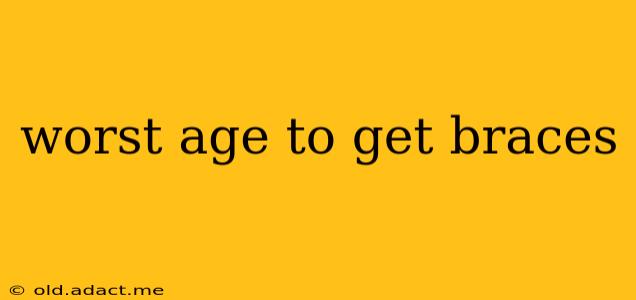There's a common misconception that there's a "worst" age to get braces. The truth is far more nuanced. While there are optimal times for orthodontic treatment, it's never truly too late to straighten your teeth. This article will explore the different age ranges for orthodontic treatment, addressing common concerns and debunking myths about the ideal time for braces.
Is There a "Worst" Age to Get Braces?
No, there isn't a single "worst" age to get braces. Orthodontic treatment can be beneficial at any age, though the approach and potential outcomes might vary. The best time to start treatment is determined by several factors, including the severity of the misalignment, the individual's overall health, and their developmental stage.
What Age is Best for Braces?
The American Association of Orthodontists (AAO) recommends that children have their first orthodontic evaluation around age 7. This early assessment allows orthodontists to identify potential problems early on, even before all permanent teeth have erupted. Early intervention can often prevent more complex and extensive treatment later.
However, this doesn't mean that adults can't benefit from braces. In fact, adult orthodontic treatment is increasingly common. Advances in orthodontic technology, like Invisalign, have made the process more discreet and convenient for adults.
What Age is Too Old for Braces?
There's no age limit for orthodontic treatment. While jaw growth is a factor in younger patients, adult teeth can still be moved effectively. The treatment plan may differ, taking into account the mature jaw structure, but successful results are still achievable.
Why is Early Intervention Important?
Early intervention offers several advantages:
- Preventing further problems: Addressing minor misalignments early can prevent them from worsening and causing more significant issues later.
- Easier treatment: Treatment is often less complex and shorter in duration when started early.
- Improved self-esteem: Straightening teeth during formative years can boost confidence and self-esteem.
- Better long-term oral health: Straight teeth are easier to clean, reducing the risk of cavities and gum disease.
What About Braces for Adults? Are They Less Effective?
Adult braces are just as effective as braces for adolescents, although the treatment might take longer. The biggest difference is the potential need for more extensive preparatory work, such as extractions or other procedures, to create enough space for the teeth to move into their correct positions. The adult jaw is fully formed, so tooth movement is achieved through different mechanisms than in adolescents.
What are the Different Types of Braces?
Several brace types are available:
- Traditional Metal Braces: The most common and often most affordable option.
- Ceramic Braces: Less noticeable than metal braces, but may be more prone to staining.
- Lingual Braces: Placed behind the teeth, making them completely invisible.
- Invisalign: Clear aligners that are removable, providing a more discreet treatment option.
Your orthodontist will help you choose the best option based on your individual needs and preferences.
How Much Do Braces Cost?
The cost of braces varies depending on factors such as the type of braces, the complexity of the treatment, and the orthodontist's fees. It's always best to discuss costs with your orthodontist upfront.
In conclusion, while early intervention is beneficial, it's never too late to consider orthodontic treatment. The best age for braces is the age when you're ready to improve your smile and oral health. Consult with an orthodontist to determine the best treatment plan for your specific situation. They can assess your needs and recommend the most appropriate course of action, regardless of your age.
